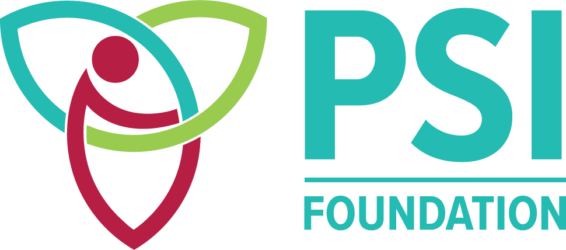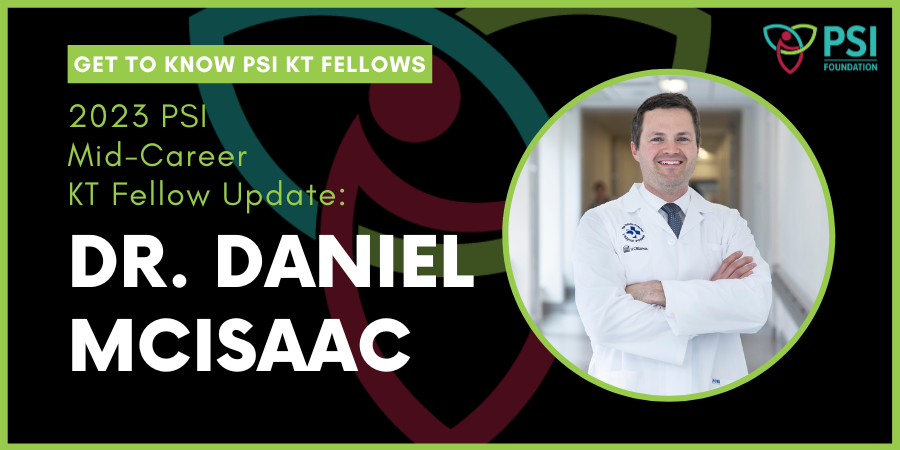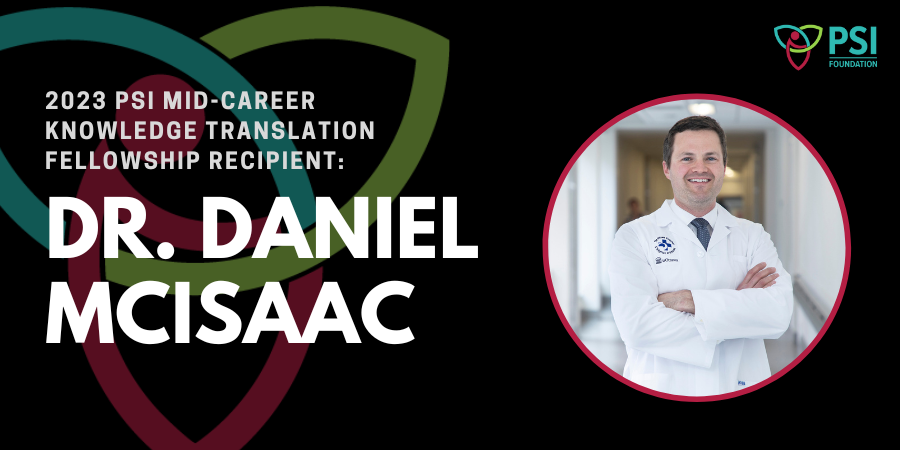Once our PSI Knowledge Translation (KT) Fellows take off from the starting line, they make strides as they move their knowledge translation activities and research program forward. As the finish line becomes clearer in their sight, we asked our fellows some questions to share their progress thus far, and what they look forward to in the remainder of their KT Fellowship.
What are some of your accomplishments from the KT Fellowship thus far?
The overarching objective of my research program, and my PSI Mid-Career KT Fellowship plan, is to use best practices in knowledge translation to support evidence-based implementation of effective prehabilitation for surgical patients in Ontario. I’m excited to report that, thanks to support from key funders like PSI, our team has made meaningful advancements toward this goal!
First, we have recently enrolled our 850th and final participant into the PREPARE Trial, an 11-center randomized controlled trial that is testing whether a home-based prehabilitation program specifically designed with, and for, older patients with frailty will lead to lower rates of patient reported disability after surgery and prevent post-surgery complications. This is currently the largest prehabilitation trial ever completed, and one of the largest trials ever specific to frailty. By early fall 2024 we will have final results, and our findings should immediately impact how we provide preoperative care for some of our highest-risk and most vulnerable surgical patients.
Next, through completion of this 850-patient trial carried out in hospitals throughout Ontario and across Canada, we’ve learned a lot about the practical aspects of delivering prehabilitation. Lessons learned include: (1) how to identify and enroll patients in prehabilitation programs far enough in advance of surgery that they have time to meaningfully improve their health before they go to the operating room; (2) how to deliver home-based prehabilitation to a diverse patient population spread widely across geographic areas; (3) what barriers patients face in trying to complete prehabilitation at home; and (4) how to support patients who have a variety of barriers to improving their exercise and nutritional behaviors in having high levels of adherence to their prehabilitation programs. Recognizing that an important secondary objective of our PREPARE trial would be not only to estimate whether prehabilitation works, but also to learn how to make it work most effectively, we had built structured assessments into our trial that are helping us to develop an evidence-based ‘prehabiliation playbook’ to support future implementation. As the PREPARE Trial winds down, we are beginning to bring these important process data and lessons learned together into a format that can inform our team’s future work, as well as the field of prehabilitation generally.
As our team’s approach to research is to constantly learn from our own experiences and the work of others in the field, while partnering with the patients, clinicians and health system leaders who will be directly involved in prehabilitation implementation, a big part of our work involves reviewing, analyzing, and synthesizing data from across the field of prehabilitation. This approach lets us identify key areas where new and more research is needed, while also allowing us to identify aspects of prehabiliation that are ready for implementation. Since being funded by PSI, our Canadian Prehabilitation Knowledge Network has completed a systematic review of all prehabilitation randomized trials ever conducted. In fact, we are now beginning to partner with groups that are involved in writing clinical practice guidelines to transform our review into a ‘living’ systematic review. Using this approach, every six months we update our search and identify all of the newly published prehabilitation trials. This allows us to have an up to date database of trials (currently numbering over 250) that our team, our partners and collaborators can use to inform their research, practice and guidelines in a tremendously efficient manner. For our team, we’ve just completed our first analyses of the database. These analyses have let us evaluate what combinations of prehabiliation components (i.e., exercise, nutrition, cognitive or psychosocial interventions), and individual components, are most likely to reduce complication rates and length of stay, and improve quality of life and physical recovery. Our findings show that on their own, exercise- and nutrition-based prehabilitation, along with multicomponent programs that include exercise, may improve outcomes in a clinically meaningful manner. Our review also demonstrates that the biggest knowledge gap that we face is an almost total lack of multicenter prehabiliation trials that can help us understand how to make prehabilitation work in the real world.
Lastly, and to help address the crucial lack of multicenter prehabiliation trials aligned with real world care, we launched the STRIVE Trial in January 2024. The STRIVE Trial is currently a 5-center trial of virtually supported home-based multimodal prehabilitation that is accessible to any adults preparing for major, elective surgery that aims to initially demonstrate that prehabilitation can be feasibly performed in a pragmatic setting (i.e., without all of the extra support and personnel that come with a tightly controlled trial). If the initial stage of the STRIVE Trial demonstrates feasibility, the trial will convert into a 12-center, pragmatic, registry-linked randomized that will evaluate whether real-world prehabilitation is effective in improving patient-reported recovery after surgery and reducing health system resource use. Findings from the STRIVE trial will be positioned for immediate translation into clinical practice.
Please describe any challenges/barriers that you have encountered thus far and what actions were/will be taken to resolve them?
Our research is informed by an integrated knowledge translation approach, meaning that all stages of our research include perspectives and input from patient partners and knowledge users who will help to implement our findings, like clinicians, health system leaders and other researchers. As such, we’ve found it very helpful to elicit opinions from our diverse partners to overcome barriers that we encounter.
Two examples that come to mind include analysis of our Canadian Prehabiliation Knowledge Network Review and design of the STRIVE Trial.
In preparing to analyze data for our systematic review, we knew that we would need to use complex statistical approaches to account for the many different types of prehabiliation interventions that exist, the different types of surgical patients who receive prehabilitation, and the variety of outcomes that our partners identified as critical to evaluate. A major challenge with using complex statistical analyses can be that their outputs are challenging to interpret. To finalize our approach to data analysis, we held a full team meeting in December 2023 to review the protocol that we’d developed as a team, as well as the initial descriptive data that we had available. Through open review of data, discussion of how statistical methods aligned with clinical interpretation, and small breakout session facilitated by our outstanding research staff, we were able to reach consensus as a group in terms of proceeding with a technique called network meta-analysis because the team felt comfortable with the underlying assumptions required and thought the approach would yield results most directly aligned with patient and clinical information needs.
In designing the STRIVE Trial, we wrestled with important questions about the types of patients that should be included in the trial and the outcomes that we should evaluate. With an executive committee guiding the trial that includes an amazing and engaged patient partner with lived experience having surgery (Ms. Gurlie Kidd: Why more patients are taking a front seat in the medical research | Ottawa Citizen), experts in prehabilitation, surgery, anesthesiology, and biostatistics, we had many perspectives to draw from. Together, reviewing data from our living review that suggested that all types of patients likely benefit from prehabilitation, we decided to be very inclusive in terms of eligibility criteria for the trial. Interestingly, in our experience with the trial to date, this decision has been validated as we’ve had enthusiastic uptake across patient risk groups. In terms of defining primary effectiveness outcomes, our patient-engagement work helped us to select a patient-reported measure of recovery as a primary outcome, but collaboration between our biostatistical leads, Ms. Kidd (our patient partner) and clinical experts helped us to define and prioritize secondary outcomes that would meet the information needs of different future knowledge users.
What are some items/deliverables that you look forward to coming to fruition in the remainder of your KT Fellowship?
Thanks to support from the PSI Mid-Career KT Fellowship, we hope to share a number of deliverables that will help to advance the science and practice of prehabiliation to the benefit of surgical patients in Ontario, Canada and around the world.
In 2024, we look forward to submission and subsequent publication of primary results from the PREPARE Trial, as well as results of our Canadian Prehabilitation Knowledge Network Systematic Review and Network Meta-Analysis. Prior to the completion of the fellowship, I expect that we will publish secondary and long-term outcome data from PREPARE, as well as initial feasibility results from STRIVE.
Having now established our overarching review as a living review, we also have analyses underway that are close to submission addressing questions around the type of patient, program and procedural factors that are associated with greatest benefit from exercise prehabilitation, and an overview of prehabilitation adherence, factors that improve adherence, and how reporting of prehabilitation adherence could be harmonized across the field.
Lastly, another important KT tool is production and dissemination of high-quality clinical practice guidelines, and I’ve been fortunate to be part of teams producing clinical practice guidelines related to prehabilitation. As a member of the American Society of Anesthesiologists’ Taskforce for the Clinical Practice Guideline for Perioperative Care of the Older Surgical Patient, I led the section on prehabilitation (expected publication in early 2025). I will also be contributing to prehabilitation clinical practice guidelines in the UK for cancer patients, due for publication in 2025.
What are some things that surprised you during your fellowship thus far?
Having the opportunity to run a large research program with lots of staff, partners, and interesting studies, I feel like most days bring at least one surprise! But for sure, some surprises over the first year of the Fellowship certainly stand out.
First, even though I’ve been involved in prehabilitation research for almost ten years, I am always surprised at the enthusiasm that patients have toward the opportunity to be involved in prehabilitation. While many trials (including some of our own that aren’t focused on prehab) face challenges recruiting enough participants, our experience with prehabilitation research has been that recruitment sometimes outpaces our expectations. Patients want access to prehabilitation, and in our experience, find that in addition to the exercise and nutritional support, being involved helps them to feel more empowered and meaningfully supported by the healthcare system.
Additionally, the speed with which some of our participants recover from having big, big surgeries is very inspiring. We’ve had people out golfing a couple of weeks after lung resections (How ‘prehab’ exercise could make surgery recovery easier | CTV News) and cross-country skiing five weeks after major bowel cancer surgery (Exercise before surgery? This cancer survivor is a believer | The Ottawa Hospital Foundation (ohfoundation.ca)). We’ve also learned some surprisingly practical lessons about helping patients to get the most out of prehab. While looking back it seems so obvious, by working with patients to get their structured feedback on their experience, we’ve developed better strategies to help people exercise even when it is too hot outside in summer and too cold outside in winter! I think that sometimes as clinicians, we give patients advice that seems so simple (“you should eat better and exercise more before surgery”). But the reality is that changing health behaviors is complex and influenced by so many factors, so unless we talk to the patients who are doing the hard work, we can’t really expect to develop programs that will be effective in real world care.


